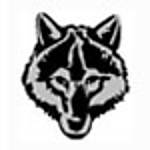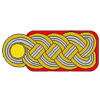Hi all. I am looking to scratch build (from wood) a model of the USCGC TANEY, a ship my father served aboard during 1950-51. From Wikipedia I saw that Tim Reynaga built a model of this ship but I cannot tell from the photo he posted, whether his build was a kit, the material used, scale, etc. For my scratch build I am looking for some basic drawings (general arrangement, profiles, etc.) of this ship. To Tim, or any others on the forum, do you have any drawings of this ship? Or any leads for obtaining such drawings? I have written to the Maritime Museum in Baltimore, where this cutter now resides, but I haven't heard back from them yet. Many thanks in advance for any leads.
Best,
John
You are viewing the archived version of the site.
Go to modelshipwrights.com for the current dynamic site!
Go to modelshipwrights.com for the current dynamic site!
Research & Resources
Discuss on research, history, and issues dealing with reference materials.
Discuss on research, history, and issues dealing with reference materials.
Hosted by Jim Starkweather
US Coast Guard Cutter TANEY
johnff

Joined: June 12, 2020
KitMaker: 11 posts
Model Shipwrights: 11 posts
Posted: Friday, June 12, 2020 - 02:02 AM UTC
Posted: Friday, June 12, 2020 - 02:23 AM UTC
You can save yourself a lot of work by just buying the plastic kit offered by Revell.
Easy to assemble and a very nice kit.
https://www.squadron.com/1-302-Revell-USA-USCG-Cutter-Roger-B-Taney-p/rm3015.htm
Cheers,
Easy to assemble and a very nice kit.
https://www.squadron.com/1-302-Revell-USA-USCG-Cutter-Roger-B-Taney-p/rm3015.htm
Cheers,
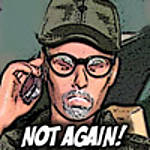
Bravo1102

Joined: December 08, 2003
KitMaker: 2,864 posts
Model Shipwrights: 31 posts

Posted: Friday, June 12, 2020 - 03:58 AM UTC
I finally track down a vintage boxing a few years ago and now they reissue it.
The kit is actually the right configuration for the 1950s.
The kit is actually the right configuration for the 1950s.

RobinNilsson

Joined: November 29, 2006
KitMaker: 6,693 posts
Model Shipwrights: 70 posts

Posted: Friday, June 12, 2020 - 04:12 AM UTC
The Floating Drydock have some drawings for the sister ship USCG Campbell (built by the same shipyard as the Taney)
G-WPG32 USCG CAMPBELL WPG32
https://www.floatingdrydock.com/G.htm
No hull lines though ....
The ships built to the same design were:
BIBB WPG-31 Charleston Navy Yard 01/14/37
CAMPBELL WPG-32 Philadelphia Navy Yard 06/03/36
DUANE WPG-33 Philadelphia Navy Yard 06/03/36
HAMILTON WPG-34 New York Navy Yard 11/10/36
INGHAM WPG-35 Philadelphia Navy Yard 06/03/36
SPENCER WPG-36 New York Navy Yard 01/06/37
TANEY WPG-37 Philadelphia Navy Yard 06/03/36
/ Robin
G-WPG32 USCG CAMPBELL WPG32
https://www.floatingdrydock.com/G.htm
No hull lines though ....
The ships built to the same design were:
BIBB WPG-31 Charleston Navy Yard 01/14/37
CAMPBELL WPG-32 Philadelphia Navy Yard 06/03/36
DUANE WPG-33 Philadelphia Navy Yard 06/03/36
HAMILTON WPG-34 New York Navy Yard 11/10/36
INGHAM WPG-35 Philadelphia Navy Yard 06/03/36
SPENCER WPG-36 New York Navy Yard 01/06/37
TANEY WPG-37 Philadelphia Navy Yard 06/03/36
/ Robin
johnff

Joined: June 12, 2020
KitMaker: 11 posts
Model Shipwrights: 11 posts
Posted: Saturday, June 13, 2020 - 07:36 AM UTC
Joe, Stephen and Robin many thanks for your suggestions. The relative ease of the Revell kit is tempting me. I am probably going to go ahead and get the kit, but also the drawings of the sister ship CAMPBELL to see what additional details might be garnered from those. Thanks again for the leads gentlemen.
Best,
John
Best,
John
johnff

Joined: June 12, 2020
KitMaker: 11 posts
Model Shipwrights: 11 posts
Posted: Saturday, June 13, 2020 - 08:06 AM UTC
Alas, kit not available at Squadron. Looks like it is still out of production. There are three on eBay for $60 to $100 plus shipping. Seems kind of steep to me, but I have no experience buying out of production kits.
John
John

RobinNilsson

Joined: November 29, 2006
KitMaker: 6,693 posts
Model Shipwrights: 70 posts

Posted: Saturday, June 13, 2020 - 09:17 AM UTC
Any item sold at an auction (which ebay often is) is worth exactly, down to nickels and dimes, as much as some sucker is prepared to pay for it.
Watch those kits for a while and see what happens.
In the meantime:
"The 327s were designed to meet changing missions of the service as it emerged from the Prohibition era. Because the air passenger trade was expanding both at home and overseas, the Coast Guard believed that cutter-based aircraft would be essential for future high-seas search and rescue. Also, during the mid-1930s, narcotics smuggling, mostly opium, was on the increase, and long-legged, fairly fast cutters were needed to curtail it. The Treasury class were an attempt to develop a 20-knot (37 km/h) cutter capable of carrying an airplane in a hangar.
The final 327-foot (100 m) design was based on the Erie-class US Navy gunboats; the machinery plant and hull below the waterline were identical."
and while looking for the lines for the Erie class I found lines for WPG-32 (Campbell) on this web-page:
https://www.floatingdrydock.com/HULL.htm
Scroll down to 'Patrol Craft' where this drawing:
HULL-WPG/8 USCG WPG32 CL. 1/96 FAIRED LINES
is listed.
The 1/302-scale of that Revell kit results in a measly 13 inch model.
Think big, go for at least 1/144. The hull lines are at 1/96 which results in model slightly over 40 inches, dividing by two to get 1/192 scale gives you slightly over 20 inches.
The drawings for Campbell are for the 1980 configuration so you would need to backdate them with photos of the Taney and your fathers memories (photos??).
https://coastguard.dodlive.mil/2018/08/tlbl-327-foot-secretary-class-cutters/
http://www.steelnavy.net/NikoTaney350FBustelo.html 1/350 resin kit, don't know if it is still on the market
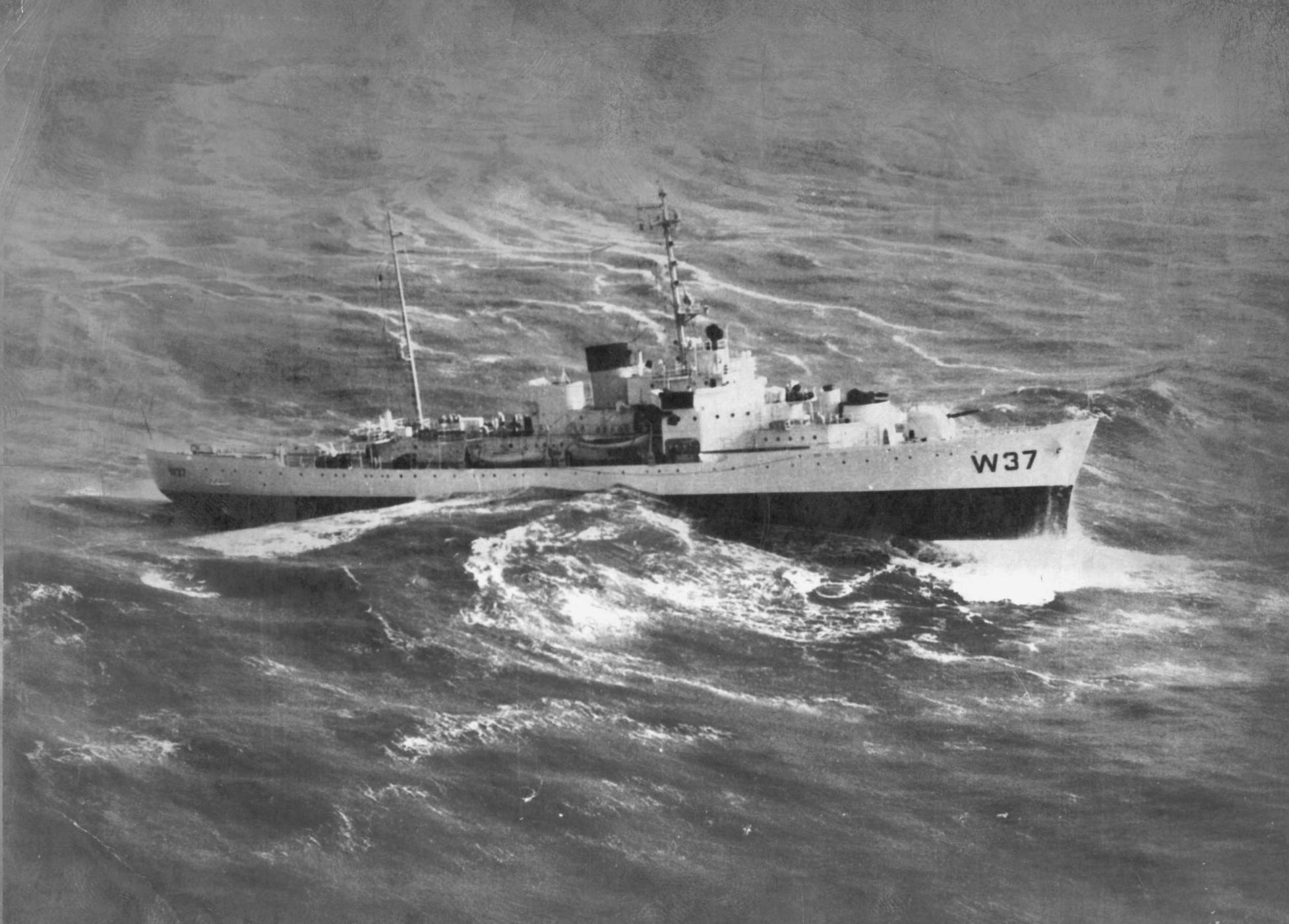
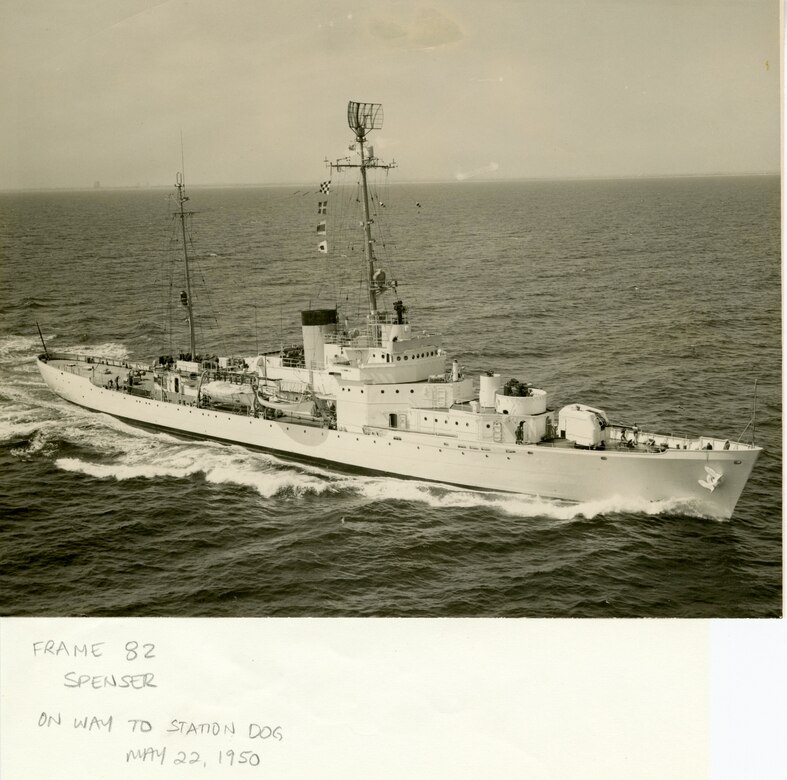
They were quite handsome ships
Watch those kits for a while and see what happens.
In the meantime:
"The 327s were designed to meet changing missions of the service as it emerged from the Prohibition era. Because the air passenger trade was expanding both at home and overseas, the Coast Guard believed that cutter-based aircraft would be essential for future high-seas search and rescue. Also, during the mid-1930s, narcotics smuggling, mostly opium, was on the increase, and long-legged, fairly fast cutters were needed to curtail it. The Treasury class were an attempt to develop a 20-knot (37 km/h) cutter capable of carrying an airplane in a hangar.
The final 327-foot (100 m) design was based on the Erie-class US Navy gunboats; the machinery plant and hull below the waterline were identical."
and while looking for the lines for the Erie class I found lines for WPG-32 (Campbell) on this web-page:
https://www.floatingdrydock.com/HULL.htm
Scroll down to 'Patrol Craft' where this drawing:
HULL-WPG/8 USCG WPG32 CL. 1/96 FAIRED LINES
is listed.
The 1/302-scale of that Revell kit results in a measly 13 inch model.
Think big, go for at least 1/144. The hull lines are at 1/96 which results in model slightly over 40 inches, dividing by two to get 1/192 scale gives you slightly over 20 inches.
The drawings for Campbell are for the 1980 configuration so you would need to backdate them with photos of the Taney and your fathers memories (photos??).
https://coastguard.dodlive.mil/2018/08/tlbl-327-foot-secretary-class-cutters/
http://www.steelnavy.net/NikoTaney350FBustelo.html 1/350 resin kit, don't know if it is still on the market

They were quite handsome ships

johnff

Joined: June 12, 2020
KitMaker: 11 posts
Model Shipwrights: 11 posts
Posted: Wednesday, June 17, 2020 - 05:19 AM UTC
Robin,
This is great information. Thank you for your time and effort in finding and sending it to me. I will keep you posted of my progress on this project.
Best,
John
This is great information. Thank you for your time and effort in finding and sending it to me. I will keep you posted of my progress on this project.
Best,
John
johnff

Joined: June 12, 2020
KitMaker: 11 posts
Model Shipwrights: 11 posts
Posted: Wednesday, June 17, 2020 - 05:23 AM UTC
PS Robin--the photos are awesome. My father joined the cutter at Alameda, CA in Dec 1950 (about 7 months after the second photo was taken) so that one will be a great resource for configuring the model to the period of his service. Thanks again.

RobinNilsson

Joined: November 29, 2006
KitMaker: 6,693 posts
Model Shipwrights: 70 posts

Posted: Wednesday, June 17, 2020 - 07:42 AM UTC
Hi John,
Maybe you would like to consider continuing with this project over in the Model Shipwrights forums:
https://modelshipwrights.kitmaker.net/modules.php?op=modload&name=SquawkBox&file=index
It could be that you would get more feedback, hints, tips and encouragement from the other ship modelers.
Here is some background reading about what 'Station Dog' was all about, possibly also an indication about what your father was doing in 1950/1951
https://books.google.se/books?id=1DHz7XaxwQgC&pg=PA84&lpg=PA84&dq=Station+Dog+1950&source=bl&ots=ujIZCq8sIz&sig=ACfU3U3fUCxiC_HQTkSV6CDVQ9itIL0XEA&hl=sv&sa=X&ved=2ahUKEwjVmcn8zYnqAhWC16YKHb4bBD0Q6AEwC3oECAoQAQ#v=onepage&q=Station%20Dog%201950&f=false
The 'Mr Gary' asking questions in those hearings seems a bit retarded but maybe he is just being a politician ...
"In June through July 1949 Taney served on Ocean Station Fox and later in July she served on Ocean Station Able. In June of 1950 she served on Ocean Station Oboe and in September she served on Ocean Station Fox. In January through February 1951 she served on Ocean Station Uncle and the following year, August to September, she served on Ocean Station Uncle. Later in 1952, from November to December, she served on Ocean Station Nan."
https://www.history.uscg.mil/Browse-by-Topic/Assets/Article/2055194/taney-1936/
Cheers / Robin
Maybe you would like to consider continuing with this project over in the Model Shipwrights forums:
https://modelshipwrights.kitmaker.net/modules.php?op=modload&name=SquawkBox&file=index
It could be that you would get more feedback, hints, tips and encouragement from the other ship modelers.
Here is some background reading about what 'Station Dog' was all about, possibly also an indication about what your father was doing in 1950/1951
https://books.google.se/books?id=1DHz7XaxwQgC&pg=PA84&lpg=PA84&dq=Station+Dog+1950&source=bl&ots=ujIZCq8sIz&sig=ACfU3U3fUCxiC_HQTkSV6CDVQ9itIL0XEA&hl=sv&sa=X&ved=2ahUKEwjVmcn8zYnqAhWC16YKHb4bBD0Q6AEwC3oECAoQAQ#v=onepage&q=Station%20Dog%201950&f=false
The 'Mr Gary' asking questions in those hearings seems a bit retarded but maybe he is just being a politician ...
"In June through July 1949 Taney served on Ocean Station Fox and later in July she served on Ocean Station Able. In June of 1950 she served on Ocean Station Oboe and in September she served on Ocean Station Fox. In January through February 1951 she served on Ocean Station Uncle and the following year, August to September, she served on Ocean Station Uncle. Later in 1952, from November to December, she served on Ocean Station Nan."
https://www.history.uscg.mil/Browse-by-Topic/Assets/Article/2055194/taney-1936/
Cheers / Robin
johnff

Joined: June 12, 2020
KitMaker: 11 posts
Model Shipwrights: 11 posts
Posted: Friday, June 19, 2020 - 11:28 AM UTC
Robin, Thank you again. How do you find this stuff? Just amazing research skills;I am impressed! It is going to be interesting reading and the photos are also a big help. I saw the 1/302 scale Revell kit on Amazon for $29 so I went ahead and bought it, thinking it would give me a better idea of the shapes and structures. You are right though, it is small. I would like to build a larger model. I put in an order with Floating Drydock for the plans but haven't received them yet. Going to check out the Model Shipwright forum. Thanks again. Best, John

RobinNilsson

Joined: November 29, 2006
KitMaker: 6,693 posts
Model Shipwrights: 70 posts

Posted: Friday, June 19, 2020 - 06:39 PM UTC
Research skills: It's mostly a matter of luck. One photo had 'on way to Station Dog' on it so I googled 'station Dog' since it sounded like an odd/unique name.
Asking google about 'ocean station Uncle' gave me this:
https://en.wikipedia.org/wiki/Weather_ship
Uncle was at 27° 40" North, 145° West
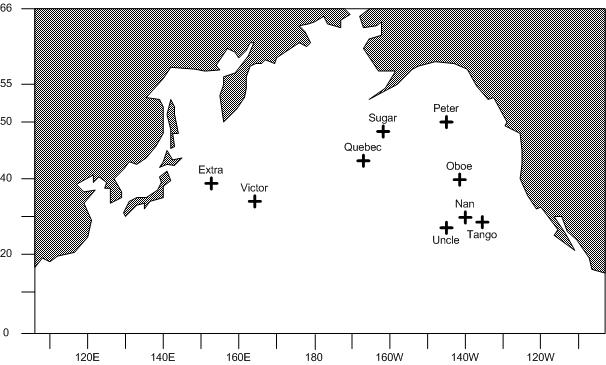
"Weather ship P's ("Peter") operations were taken over by Canada on December 1, 1950, which allowed the Coast Guard to begin operating station U ("Uncle") 2,000 kilometres (1,200 mi) west of northern Baja California on December 12, 1950."
In April 1952 the ICAO signalling alphabet was changed so Uncle became Union.
Let me know if you would like to have this thread moved to one of the Shipwrights forums, Research & Resources could be a good starting point.
Cheers / Robin
Asking google about 'ocean station Uncle' gave me this:
https://en.wikipedia.org/wiki/Weather_ship
Uncle was at 27° 40" North, 145° West

"Weather ship P's ("Peter") operations were taken over by Canada on December 1, 1950, which allowed the Coast Guard to begin operating station U ("Uncle") 2,000 kilometres (1,200 mi) west of northern Baja California on December 12, 1950."
In April 1952 the ICAO signalling alphabet was changed so Uncle became Union.
Let me know if you would like to have this thread moved to one of the Shipwrights forums, Research & Resources could be a good starting point.
Cheers / Robin

Bravo1102

Joined: December 08, 2003
KitMaker: 2,864 posts
Model Shipwrights: 31 posts

Posted: Friday, June 19, 2020 - 09:32 PM UTC
It's worth a visit to Baltimore for USCG Taney. A visit would probably give you many of the details on the ship you need.
She's the only surviving ship that was present in Pearl Harbor December 7, 1941.
I've seen some of what Robin provided because the material is in the exhibits on the ship.
I have the kit because I only have room for a 13" model and barely enough for that.

She's the only surviving ship that was present in Pearl Harbor December 7, 1941.
I've seen some of what Robin provided because the material is in the exhibits on the ship.
I have the kit because I only have room for a 13" model and barely enough for that.

johnff

Joined: June 12, 2020
KitMaker: 11 posts
Model Shipwrights: 11 posts
Posted: Sunday, June 21, 2020 - 06:33 AM UTC
Robin, thanks again for your research effort. It would be great to move this thread to the shipwright's forum, or any other forum that you think might be more appropriate for what I am trying to do.
Stephen, last year I did go visit the ship but at the time was not thinking about building a model. As a result I did not take as many photos of details as I would have liked. I do plan another visit and will load up on more detailed pics. Have you started your model? If so, are you building straight from the kit, or are you making any modifications? One of the things I was thinking about doing is removing the railings that are molded into the hull and deck houses, and replacing them with photo etch. I haven't found any PE for this particular model, so guessing I have to find some generic PE rails. Are you doing anything like this?
Thanks again guys!
Best,
John
Stephen, last year I did go visit the ship but at the time was not thinking about building a model. As a result I did not take as many photos of details as I would have liked. I do plan another visit and will load up on more detailed pics. Have you started your model? If so, are you building straight from the kit, or are you making any modifications? One of the things I was thinking about doing is removing the railings that are molded into the hull and deck houses, and replacing them with photo etch. I haven't found any PE for this particular model, so guessing I have to find some generic PE rails. Are you doing anything like this?
Thanks again guys!
Best,
John

RobinNilsson

Joined: November 29, 2006
KitMaker: 6,693 posts
Model Shipwrights: 70 posts

Posted: Sunday, June 21, 2020 - 06:58 AM UTC
Topic moved from 'Scratchbuilders' / Robin
TimReynaga

Joined: May 03, 2006
KitMaker: 2,500 posts
Model Shipwrights: 1,830 posts

Posted: Sunday, June 21, 2020 - 08:44 AM UTC
Quoted Text
Hi all. I am looking to scratch build (from wood) a model of the USCGC TANEY, a ship my father served aboard during 1950-51. From Wikipedia I saw that Tim Reynaga built a model of this ship but I cannot tell from the photo he posted, whether his build was a kit, the material used, scale, etc. …
Best,
John
Hi John,
The USCG Taney model I built was from Revell's 1/303 scale U.S. Coast Guard Cutter Taney, a golden oldie dating from 1956.
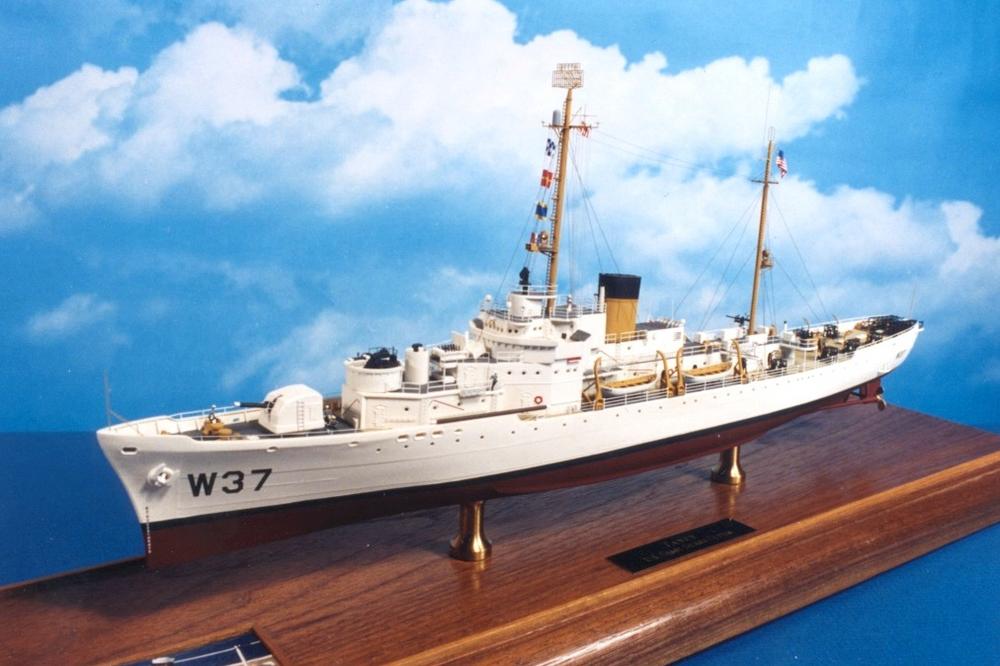
A fairly accurate kit overall, it unfortunately suffers from many plastic model kit shortcomings typical of the time: indifferent parts fit, simplified weapons, heavy details, and of course those awful solid molded hand rails. Intended for the baby boomer child market, early issues even had the parts divided among sprues molded in white, black, and orange-brown plastic so kids wouldn't have to paint them! This semi-toy approach makes this kit a quick one to assemble but a bit of a challenge to detail. Still, it was one of the first plastic model ship kits ever, so I guess it can be forgiven for being less than today's state of the art.
Subsequent issues over the years (sometimes as the Campbell, more often as the Taney) have appeared in all white plastic with new box art and decals. The model is a pretty good representation of the ship as it appeared in the early 1950s, with only a few minor inaccuracies:
•the fantail (under the depth charge tracks) should be unplanked steel deck
•main deck sections beneath the boats should be unplanked steel
•bridge wing decks should be planked
•decals for all issues of the kit have red "NRDC" (Campbell's call sign) markings for the balloon shelter; Taney was "NRDT"
Gold Medal Models (GMM) set 300-17 REVELL USCG CAMPBELL / EASTWIND photoetched brass and HR Products white metal weapons go a long way to update this classic kit. I built this model as a gift for my dad who served aboard in the 1950s, so I went all out and added other refinements as well:
MAIN DECK:
•teak decks overlaid with Evergreen .025" spaced V groove scribed styrene plastic sheet
•anchor handling gear replaced; brass chain with capstans and various pieces scratchbuilt
•mooring bitts replaced with parts cast in resin from a scratchbuilt original
•oil bunker vents made from wire
•GMM photoetch and brass rod used to replace molded in railings, platform supports, and fairleads
•deck hatches scratchbuilt using styrene and adapted GMM and Flagship Models photoetch door parts
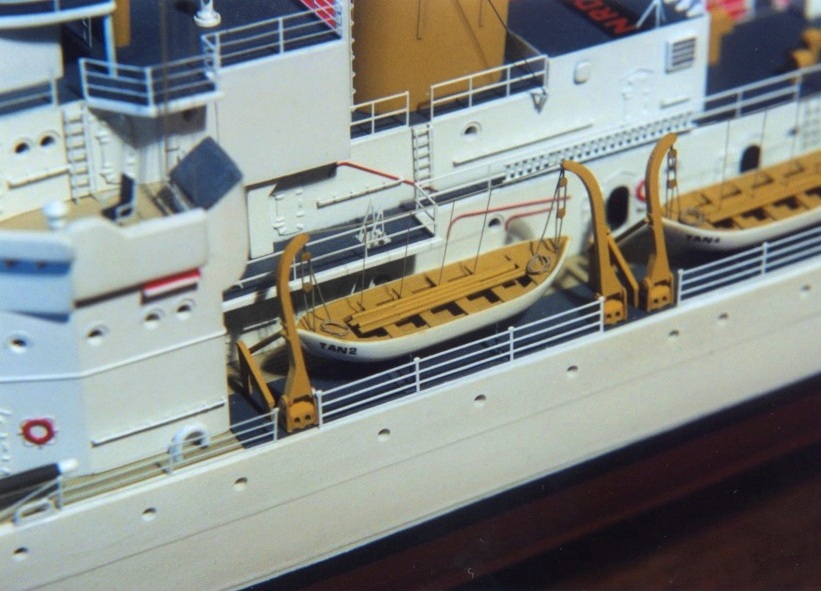
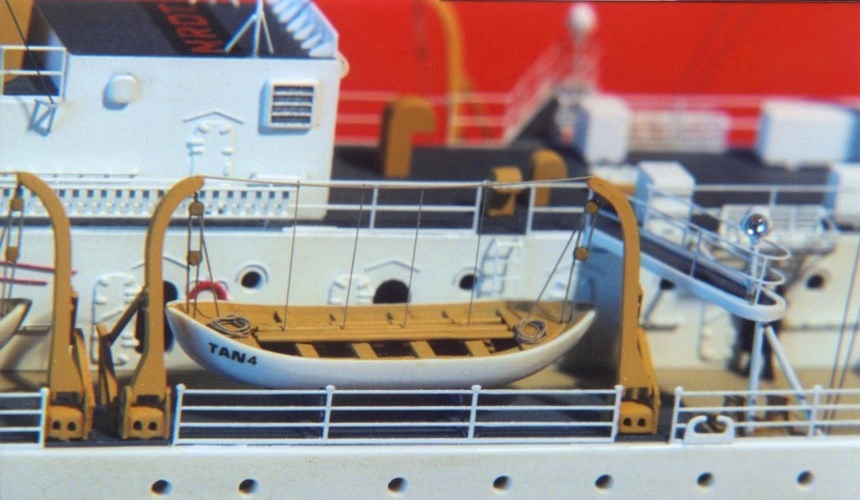
•boats improved with scribed plastic floors, plastic strip thwarts, brass oars, decal markings
•boat cradles adapted from Tom's Modelworks 1/350 Arizona photoetch parts
•boat davits replaced with parts cast in resin from scratchbuilt original
•kit boat booms replaced with telescoped brass tubes
•large vent and winch on main deck aft scratchbuilt
•crew figures adapted from White Ensign Models photoetch 1/350 British carrier crew
HULL:
•molded in railings removed, replaced with photoetch
•kit anchors replaced with modified Tamiya 1/350 King George V parts
•excess scuppers on forward bulwark (correct for Campbell but not for Taney) filled in
•kit bulwark tops and inboard supports replaced with styrene strip
•bullnose added at forepeak, tow hawser opening and collar at stern
•incorrect kit propeller struts replaced, new propeller guards adapted from photoetch parts
SUPERSTRUCTURE:
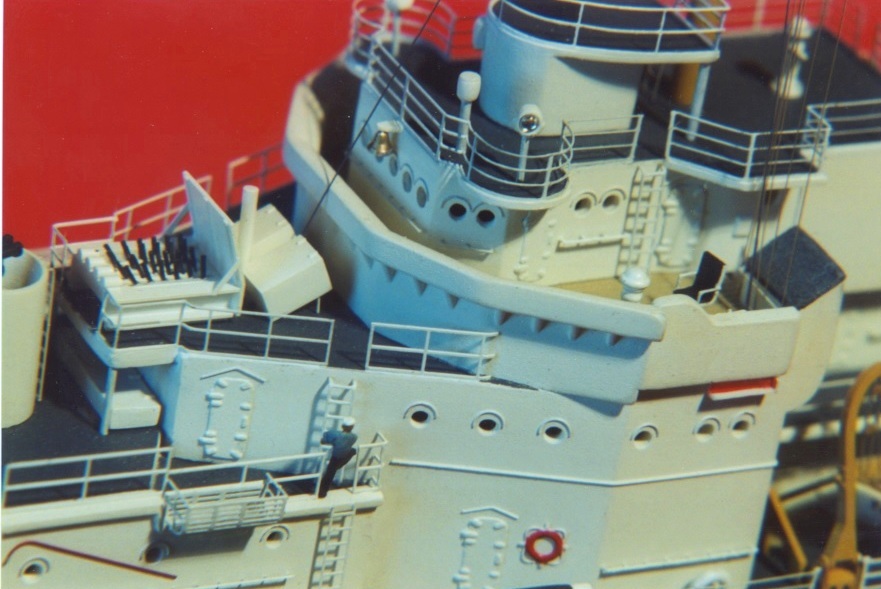
•molded in railings removed, replaced with photoetch
•kit bulkhead details removed and replaced with wire door and porthole eyebrows, red firefighting fog applicators and axe, photoetch doors, ladders, hoses, handgrabs, liferings and stokes litters
•kit portholes drilled out for uniform diameter, some additional ports added
•interior bulkheads and decks visible through open doors on deckhouse built up from plastic sheet
•auxiliary binnacle from Revell Emden atop CIC, scratchbuilt gyrocompass repeater above pilothouse, ship's bell adapted from model railroad part
•scratchbuilt captain's chair and pelorus added to each bridge wing
•smooth bridge wing decks covered with scribed styrene sheet
•canvas covers for flag bags simulated with painted tissue
•all vents and lockers replaced with new ones made from sheet plastic

•four small spotlights made from Tamiya KGV parts, MV Products lenses, and wire; two of these fitted to scratchbuilt angled platforms
•floater baskets (six, in three styles) fabricated using scrap photoetch radar screens and wire
•TAJ antenna tuning support near funnel made from telescoped brass tubes with photoetch ladder
•funnel surface detail removed and replaced with plastic strip; funnel access ladder, platform, and whistle added using photoetch scraps and wire
•scribed plastic rolldoor added to the balloon shelter aft of funnel
•incorrect kit "NRDC" (Campbell) decal replaced with correct "NRDT" (Taney) marking atop balloon shelter
WEAPONS:
•5" gun barrel replaced with properly tapered part turned from plastic sprue; styrene access doors and photoetch ladders added to gunhouse; blast bag retainers made from wire
•40mm mount replaced with HR Products part (AB20 40mm gun, twin) modified with scrap photoetch mesh floor and GMM details
•40mm gun tub ready use ammunition racks fashioned from photoetch ladders
•hedgehog ASW rocket launcher and reload lockers scratchbuilt using plastic sheet, rod, strip, and photoetch ladder parts
•fire control directors adapted from Tamiya 1/350 Missouri parts
•20mm Oerlikons replaced with HR parts (AB19 20mm gun, single) detailed with brass rod and GMM photoetch
•20mm Oerlikon platforms and angled balloon launching platforms replaced with sheet styrene/photoetch parts
•20mm ready use ammunition lockers scratchbuilt
•kit depth charge throwers replaced with parts cast in resin from a modified HR part (AB25 k-gun), DC reload racks replaced with GMM photoetch; davits replaced with bent brass rods with photoetch pulleys
•kit depth charge tracks at stern replaced with modified GMM photoetch parts
MASTS AND RIGGING:
•kit masts replaced with telescoped brass tubing
•sensor dome on foremast made from plastic sprue turned on a Dremel
•radar, yards, ladders, IFF, and other details from GMM photoetch brass
•mast-mounted searchlights adapted from 1/350 Tamiya Fletcher parts with MV Products lenses and scratchbuilt bases
•jackstaff, flagstaff, halyards, stays and antennae made from various thicknesses of copper wire
•U.S. National flag, U.S. Coast Guard ensign and Taney N-R-D-T call sign signal flags from Dunagain decals over tinfoil
johnff

Joined: June 12, 2020
KitMaker: 11 posts
Model Shipwrights: 11 posts
Posted: Sunday, June 21, 2020 - 12:04 PM UTC
Tim,
WOW! THAT is an impressive effort. Your mods obviously changed this child's kit into a very challenging project. Thank you for all these details; they are going to be a great help. I was wondering if the depth charges and racks were still in place in the 1950s, but your model answers that one for me. I'm going to have to give your upgrades a try. Many thanks for the info!
Best,
John
WOW! THAT is an impressive effort. Your mods obviously changed this child's kit into a very challenging project. Thank you for all these details; they are going to be a great help. I was wondering if the depth charges and racks were still in place in the 1950s, but your model answers that one for me. I'm going to have to give your upgrades a try. Many thanks for the info!
Best,
John
TimReynaga

Joined: May 03, 2006
KitMaker: 2,500 posts
Model Shipwrights: 1,830 posts

Posted: Sunday, June 21, 2020 - 01:05 PM UTC
Quoted Text
Tim,
WOW! THAT is an impressive effort. Your mods obviously changed this child's kit into a very challenging project. Thank you for all these details; they are going to be a great help. I was wondering if the depth charges and racks were still in place in the 1950s, but your model answers that one for me. I'm going to have to give your upgrades a try. Many thanks for the info!
Best,
John
Thank you, John, you are very kind. I went a little farther than my usual in detailing this one because it was a special gift for my dad (he served aboard in the late 1950s). Part of my research involved an e-mail correspondence with John Fail, QMC USCG (retired) who was stationed on Taney in 1959-1961.
I think you might find it of interest for your build:
Were the NRDT letters on the weather balloon shelter red on gray deck or red on a black panel on the gray deck?
NRDT was international orange painted on a black panel over blue deck gray
Were the weather decks on the bridge wings planked wood? What other weather decks were in natural wood?
Yes, the bridge wing decks were teak wood as the main deck was. Only the bridge wings and main deck were wood.
What were the colors of the interior decks and bulkheads? My father once commented that the interior decks were green in 1957.
Most of the passageways were dark green linoleum tile. Bulkheads depended on the compartment. As I remember most of them were a light green, although some were light beige.
CAMPBELL’s boats had Cam 1 painted on their bows. Did the TANEY boats have Tan 1, Tan 2, Tan 3, and Tan 4 painted on them?
Yes TAN1, TAN2, TAN3, TAN4 - no other markings
The depth charge racks were black. Were the actual depth charges also black, gray, or something else?
The depth charges were black. They were painted by the gunnery division to match the racks which were black. When delivered/picked up from the ammo depot they were gray.
I have a photo which seems to show that the inside of the tub containing the twin 40mm mount was painted black. Is this correct?
It was black. The inside of the tub had racks for 40mm ammo.
What was the purpose of the angled platforms projecting from the ’midships deckhouse?
They had small spot lights at the end for illuminating the main deck and for night operations but they were primarily for releasing RAWIN/RADIOSONDE balloons. When getting ready to launch a balloon the weather birds would call the bridge and tell us they were ready to launch. We would then bring the ship around and get underway at 5-7 knots, put the wind 20-30 degrees on the port or starboard bow and then notify them that they could launch.
The Revell kit shows numerous lines laid out neatly on the main deck. Were they left there all the time? What purpose did they serve?
Not sure what you mean about the numerous lines, you might be referring to an attempt to simulate wood planking for the main deck. There is an error on the main deck forward. The model attempts to continue the wooden deck all the way to the focsle. In reality the wooden deck ended right at the forward part of the main deckhouse. This error is also continued back aft. The wooden deck ended just aft of the last depth charge racks. There is also an attempt to present mooring lines as laid out on the main deck. Mooring lines were only on deck when entering and departing port. They were stored when under way. In the late 1950’s (about 1958) the aft four (2 on port - 2 on starboard) depth charge racks were removed along with the 20mm guns on the overhangs on the aft part of the deckhouse. The stern release depth charge racks were also removed about 1958. If I am not answering this correctly you might need to describe the markings more.
What was that tall pipe located on the deck near the forward port side of the funnel? Some sort of vent?
This is a “TAJ” radio transmitter antenna tuning support.
I notice in the pics that you have some large scale plans on your workbench. Where did you get them?
I got those plans from Lee at Scale Shipyard in Long Beach. They came with the 1:96 hull of the Taney that I bought from him. I also have another set of large scale plans that I got from Taubman back in NJ. The ones from Taubman were for Campbell (WPG-32) but very, very close to Taney. The neat thing about Taubmans plans are that you also get plans for the class as they originally appeared when they were constructed in the 1930’s. They looked very, very different than they do today. The Taubman and Lee’s plans depict the 327’ class after the modifications they received in the late 1960’s. For example the oceanographic lab and the tripod mast on the aft end of the deckhouse did not exist when your dad and I were on Taney. The model represents what it looked like then.
What was the color of the radar screen at the top of the foremast?
The radar antennas were the same color as the mast etc., Spar. Vertical antennas near the front of the pilot house were aluminum color with porcelain bases which were a very dark maroon color. The Radio Direction Finder antenna at the top of the main mast was medium gray (just the dome part was gray, the support structure was Spar.
Underway photos show TANEY flying her NRDT call sign flags from the foremast. When were these flags shown?
All military ships when entering and departing port fly their call sign. After clearing nearby land they were hauled down. However, once in a while when working with other military vessels a ship will fly it’s callsign, but not very often. Basically for visual identification although the hull number was the most important for other Coast Guard ships but often we would meet up with a navy ship, exchange Commanding Officers flag numbers etc. to determine who was going to render passing honors etc. and it was much easier to read their call sign rather than try to identify it by hull number. Also civilian ships had no idea what the hull number indicated so if they wanted to communicate with you visually they could call you by your call sign.
There was a cutout section on the angled part of the superstructure abeam the bridge at main deck level evident in some photos. On the preserved TANEY today (and the Revell kit) this area is solid. What was the purpose of the open section? When was it enclosed?
Good question. We used to gather around that opening like a bunch of seagulls sitting on a fence and tell sea stories. Pictures that I have of Taney around the 1968 area still show it open. As you say it is closed now. I can only guess that it was closed to reduce the amount of water entering it in rough seas. However, I don’t remember it ever being a problem. There was no real “purpose” that I can remember other than air flow, etc.
The Revell kit has a line hanging slack between two of the scuppers on the hull forward. This appears on some (but not all) photographs of TANEY and her sisters as well. What was its purpose? At what times was it rigged?
This line could be one of two things. Most likely it is a “sea painter” used to bring a small boat alongside. The sea painter was passed to a small boat while the ship was underway at a slow speed and the motion of the ship and the small boat would cause the small boat to “swing” in towards the ship and come under the davits for hoisting. The sea painter had to be pretty long to accomplish that. I am pretty certain that is what that line was for. It could be for the boom that was used to moor small boats when the ship was at anchor. One end of the boom was swung out perpendicular to the ship with a line leading from the end of the boom forward and another aft. The boats would then come under the rigged out boom and a jacobs ladder would be extending from the boom down to the boat and the liberty party etc. could climb up and down the ladder up to the boom and then walk to the ship on the boom.
Your model shows some open sections on the main deck around the boats and DC racks which are not planked. Revell depicts these as planked. Were these areas unplanked steel?
Yes, they were steel and I should have pointed that out as an error in the Revell model when I answered your first e-mail.
The Gold Medal Models photoetch set for the Revell TANEY includes a number of stokes litters for stowage on the superstructure sides. Are these correct for the 1950s, and where should I attach them?
Yes, that would be correct for the 50’s and they were international orange with floatation on each side. Although it seems to me as I think about it we may have had some that were white. Either one would be correct but for accuracy I would go with the international orange.
What equipment was mounted on the pilothouse roof, in the area behind the foremast? The Revell kit has a couple of unidentifiable squarish blobs here. I have an overhead photo of 1950's TANEY which shows a covered object about the shape and size of a binnacle.
The Gear on top of the Pilot house is a fire control director. The little "house" that was immediately on top of the pilot house is where the Fire control director operator was housed. This house is identified by the railing around it and the two stanchions aft on it. The blob is the actual fire control director radar antenna which is on top of the little house.
The wood planked bridge level weather deck looks pretty bare. Was there any equipment there, such as a captain's chair, binocular mounts, or whatever? Exactly where was this equipment mounted?
The wings of the bridge had a pelorus on each wing which is just forward and inboard of the search light that is on the wing of the bridge in the kit. You should mount it right where the wing of the bridge makes the first angle toward the centerline of the ship and slightly inboard. There was a captain's chair on each wing of the bridge just aft of the pelorus (almost immediately inboard and forward of the search light on the wing of the bridge).
Where did the hoists from the aftermast yardarm attach below? There is also a solid, rectangular structure on the centerline just in front of the mast on the Revell kit-was this a flag or flare locker? Was it an open framework?
To my memory there were no hoists at the mainmast. There was certainly one going to the gaff on the mainmast for flying the national ensign when underway. It secured to a small cleat on the base of the mainmast. Don't remember which side it was on. The box just forward of the mainmast was a pyrotechnics locker. If I remember correctly the lockers on each side of the mainmast were lifejacket lockers. They were definitely not flag lockers since no flaghoists are conducted from the main mast.
Where was the gangway stowed when not in use? The Revell kit shows two, one on each side at main deck level mounted outboard of the safety rails near the after bulwarks. Is this right? My overhead picture shows what looks like a solid object in that spot, but it may be a covered gangway as it is the right shape and length. The picture also clearly shows a heavy ladder-like object mounted horizontally outside the railing on the main deckhouse, abaft the funnel. Was that it? I know CAMPBELL had hers stowed there...
We only carried one gangway. When underway it was stowed on the main deck port side just about over the location of the screw guard. Remember when I was on it the two aft depth charge racks on each side did not exist so we had that area free for storing the gangway. I dont know what the object is that you are referring to abaft the funnel. None of my pictures show anything like that anywhere near that location.
The photo shows orange life rings stowed on either side of the angled part of the superstructure forward. Were there any others?
There were also life rings on the inside of the wings of the bridge just below where the search lights are. Also on the main deckhouse between the small boats and on the aft bulkhead of the main deckhouse.
Where were the stokes litters stowed?
I can't remember for sure but I think they were stowed on the railings on the 01 deck just aft of the balloon catwalks. Speaking of the 01 deck. The 20MM guns near the mainmast were removed before I reported aboard. Don't know if they were still there when your dad was on it or not.
The gear on the pilothouse roof I was asking about before was actually aft of the fire control office and the foremast, in that little open area just forward the funnel. Was there anything in that space? Revell had a couple of squarish shapes molded to the deck there.
Wow, you are really taxing my memory! If I am not mistaken the object on top of CIC was a magnetic compass binnacle for emergency steering. There was a Gyro compass repeater just forward of the fire control stack on the port side just off the centerline of the ship.
What color were the boat booms?
The boat booms where stained to look like dark mahogany with the end fittings at the ship end and the outer end painted white.
Where were the firehose racks located?
I am hard pressed to remember where the fire hose racks were precisely located but certainly almost anywhere along the main deck house port and starboard. There was one forward of the air castle on the starboard side.
Were the orange rectangular rafts there when you were aboard?
No, the life rafts that came with the kit did not exist when I was on the Taney. We had inflatable rubber life rafts. There were four of them. One was in a rack on starboard side on the 01 deck directly perpendicular to the hedgehogs. It was rack that hung out over the main deck. The rack was about 5-6 feet long and extended over the main deck about 3 feet. The raft was not in a container as they are on ships these days. There was another identical one on the port side in the same location. There was another one on the 01 deck just aft of the balloon catwalk also hanging over the main deck. There was one on the starboard and port side. The life rafts were quite large 30-40 man rafts but they were of course folded up into a bundle about 5 feet long and 3-4 feet wide and stored in the racks. The rafts were flat black.
A 1950s photo of the CAMPBELL shows a small platform beneath the whistle on the front of the funnel. Did TANEY have one?
I vaguely remember the little platform on the forward part of the stack and I think it was used for access to the top of the stack. It was nothing more than a small platform that one could stand on if need be. I certainly remember a ladder going up the front of the stack foraccess to it. It was not your standard ladder tho, it was steel rod formed and then welded to the stack to form a ladder, similar to what was used for mast climbing on many ships.
All the best
John
johnff

Joined: June 12, 2020
KitMaker: 11 posts
Model Shipwrights: 11 posts
Posted: Sunday, June 21, 2020 - 02:05 PM UTC
Tim,
I really enjoyed reading your exchange with QMC Fail. What great resources you had in building the model for your Dad. My Dad never talked about his service in the Coast Guard, and unfortunately I did not become curious about it until after he passed. I learned about his service aboard the TANEY when I obtained his service record last year. In any event, it looks like its going to be a steep learning curve to get this ship's details right. Thanks for sharing this additional info.
Best,
John
I really enjoyed reading your exchange with QMC Fail. What great resources you had in building the model for your Dad. My Dad never talked about his service in the Coast Guard, and unfortunately I did not become curious about it until after he passed. I learned about his service aboard the TANEY when I obtained his service record last year. In any event, it looks like its going to be a steep learning curve to get this ship's details right. Thanks for sharing this additional info.
Best,
John
TimReynaga

Joined: May 03, 2006
KitMaker: 2,500 posts
Model Shipwrights: 1,830 posts

Posted: Monday, June 22, 2020 - 12:51 PM UTC
Good luck with your build, John, and do feel free to post any questions as you proceed; I or someone else on this forum might well be able to help you out!

Taney in 1959 and 2009

Taney in 1959 and 2009
johnff

Joined: June 12, 2020
KitMaker: 11 posts
Model Shipwrights: 11 posts
Posted: Tuesday, June 23, 2020 - 04:09 AM UTC
Thanks again Tim. I'll keep you posted.
Best,
John
Best,
John
johnff

Joined: June 12, 2020
KitMaker: 11 posts
Model Shipwrights: 11 posts
Posted: Monday, June 29, 2020 - 09:52 AM UTC
Tim,
Not really related to my model build, but thought you might be interested in the following if you haven't heard about it already. I contacted a retired Coastie friend of mine to see if he had any contacts that might be able to score me some drawings of the TANEY. He posted an inquiry on a couple FB pages populated by retired Coast Guardsmen. I got a couple leads (which I am tracing) but also got what I think is very troubling news. Apparently the governing board of the Maritime Museum in Baltimore voted to change the name of the TANEY and have already torched the name from the transom. I have a photo but can't seem to attach it. I'll try to DM it.
Not really related to my model build, but thought you might be interested in the following if you haven't heard about it already. I contacted a retired Coastie friend of mine to see if he had any contacts that might be able to score me some drawings of the TANEY. He posted an inquiry on a couple FB pages populated by retired Coast Guardsmen. I got a couple leads (which I am tracing) but also got what I think is very troubling news. Apparently the governing board of the Maritime Museum in Baltimore voted to change the name of the TANEY and have already torched the name from the transom. I have a photo but can't seem to attach it. I'll try to DM it.

Removed by original poster on 06/30/20 - 00:37:59 (GMT).
TimReynaga

Joined: May 03, 2006
KitMaker: 2,500 posts
Model Shipwrights: 1,830 posts

Posted: Monday, June 29, 2020 - 10:56 AM UTC
Quoted Text
Tim,
Not really related to my model build, but thought you might be interested in the following if you haven't heard about it already. ...the governing board of the Maritime Museum in Baltimore voted to change the name of the TANEY and have already torched the name from the transom.
John, I agree it is troubling that history is apparently being erased.

Even though the ship was actually named after Roger B. Taney because of his service as Secretary of the Treasury (as were all the "Treasury class" cutters), he is to many a symbol of racism; he was the same Taney who later as Chief Justice of the Supreme Court wrote the notoriously racist Dred Scott decision (black people "are not included, and were not intended to be included, under the word 'citizens' in the Constitution, and can therefore claim none of the rights and privileges which that instrument provides for and secures to citizens of the United States", etc.)
Alternate names have been suggested for the museum, such as “Cutter 37”. I hope a compromise can be reached that could retain the historical identity of the ship without seeming to honor racism.
Nevertheless, reassessing history is not the same as remaking the future; I feel strongly that we must ensure that efforts to change names and suppress offensive symbols evolve into more a more substantial national commitment to correct racial inequities and fully achieve the promise that is America.
 |




